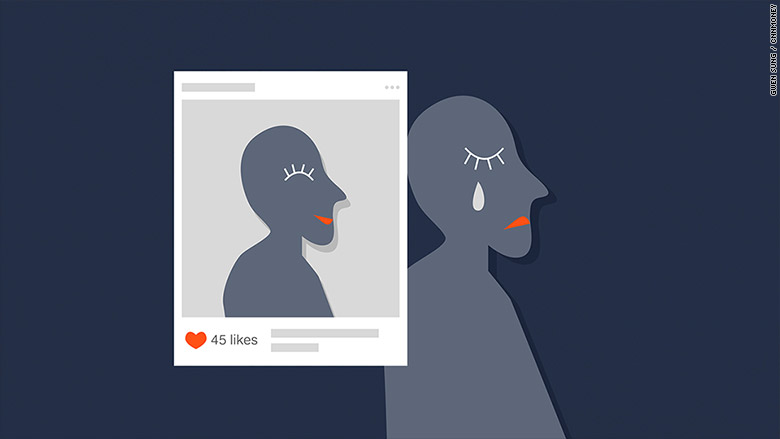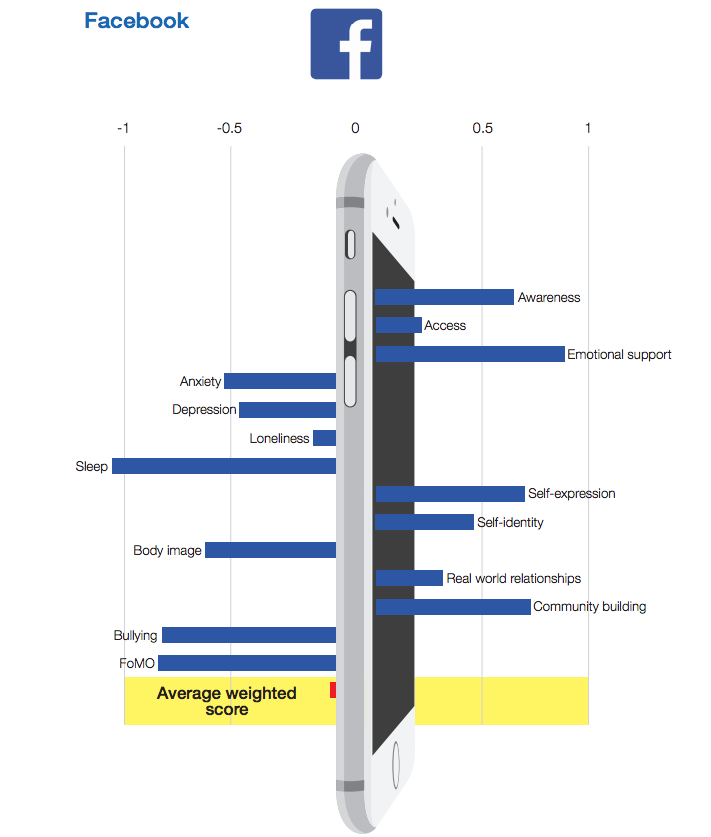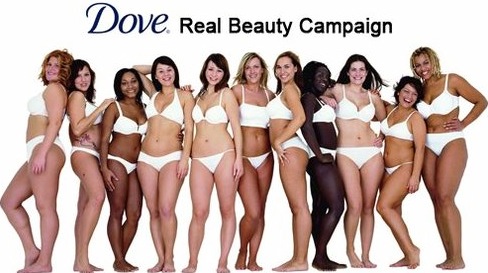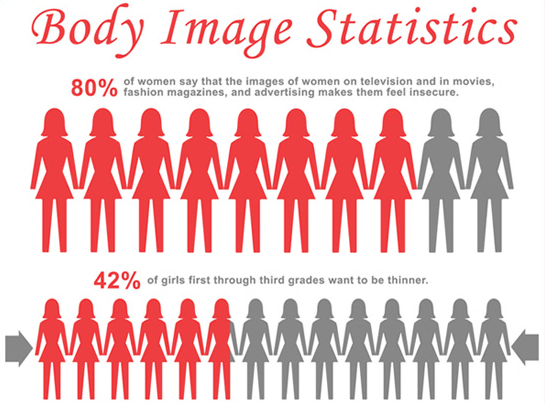How Social Media Contributes to Body Dysmorphic Behavior
Most of us have something that we don’t like about our appearance—a crooked smile, large eyes, a flabby stomach, the list goes on. Most people accept these flaws and move on with their daily lives, but people who suffer from body dysmorphic disorder (BDD) become fixated on that imperfection and think about their real or perceived flaws for hours each day. These obsessive and controlling thoughts can cause you to spend excessive amounts of time trying to cover or conceal the flaw. BDD sufferers can't control their negative thoughts and don't believe people who tell them that they look fine.
Body dysmorphic disorder, also known as dysmorphophobia, is a common affliction, affecting approximately 1.7% to 2.4% of the population, with roughly equal distribution among men and women. "It can happen to pretty people, it can happen to people who are average-looking," Dr. Feusner says, a professor of psychiatry at UCLA who has conducted studies on the condition. While the disorder is serious enough that it can lead to institutionalization or suicide, practitioners worry that with so little known about it, even professional therapists may fail to diagnose it.
With the rise of convergence, social media has become a critical part of our everyday lives. Numerous sources say that these platforms are to blame for instilling insecurities in young people. Most people ages 15 - 27 are actively engaged in at least one or more forms of social media. In the age of Instagram models, Twitter-famous celebrities, and Tumblr babes, it is no wonder our generation has become so obsessed with the concept of perfection. When scrolling through our feeds, we are exposed to a highly-curated selection of photos, images, and snaps that are far from our reality. Matthew Schulman, a plastic surgeon in New York, says “patients have been coming in with Snapchat filtered selfies to show what they want done to their body.”
Constant exposure to altered images can lead to an unhealthy pressure to achieve unrealistic body types, which can result in body dysmorphic behaviors. Social media has become increasingly dangerous, especially for teens, who are most susceptible to suffering from insecurity and depression. At this age, girls and boys are still learning about their own anatomy while dealing with hormones, pressures from school, and other home life distractions. These factors, combined with constant pressure from the media telling young people that they should be thin, curvy, sexy, brainy, cultured or woke, can be very overwhelming on the psyche.
In recent years, social media platforms like Instagram, Twitter, and Snapchat’s business models have changed dramatically. In the good old days, social media was used purely for fun and entertainment. These platforms were originally launched as a medium of expression, used to post pictures, share thoughts, and communicate with others. But social media isn’t an external being anymore; it has become an extension our ourselves. These new developments in social media are directly responsible for the disconnect between mind and body. Nowadays, users of media platforms are seeking to brand themselves, or more commonly, to promote their businesses.
Before social media became a profession, people had the ability to post silly and embarrassing images without worrying about others scrutinizing or judging them. Now, posting has become a daunting process of filters, quality, theme, purpose, hashtags and captions. Our feeds have become an overly-curated forum in which people post to seek approval from others by meeting societal standards of self-image. Crawford, a researcher on children’s obsession with media, states, "the problem is that this 'cyber self' can become increasingly distant from the real-world self, and it can become harder to live up to the perfect image of self that is projected online.”
Social media isn’t the only problem. A lack of representation in all mediums of expression are to blame for this occurrence. Imagine flipping through a magazine and seeing no one who resembles yourself. Fashion and beauty publications are notoriously known for photoshopping models, lacking in diversity, and neglecting to include all body types on their covers.
Today, acceptance has become parallel to conformity. The 2011 documentary, Miss Representation, challenges the media's limited portrayal of what it means to be a powerful woman. The film’s premise largely explores the under-representation of women in positions of power and its influence in America. In the digital age, everyone is seemingly affected by the phenomenon of being picture perfect, when in reality we all suffer from flaws.
The media is constantly pushing beauty routines with headlines like, 11 Easy Ways to Get Your Best Brows Ever, 13 Secrets to Long, Thick, Shiny Hair, 17 Healthy Ways to Lose Weight Fast, and the list goes on. Content like this is quick and easy to produce; however, exposure to such beauty routines can send a negatively suggestive message to young readers. Magazines and digital media publication backhandedly push their agenda on susceptible readers; consequently, readers yearn to fix something about themselves that they didn’t perceive as a flaw before. The media is an authoritative force that can greatly affect perception of one’s self.
Although the media greatly contributes to BDD, there are varying factors that are to blame for obsessiveness with flaws and perception. Each person displays different symptoms and degrees of obsession. To truly understand someone who suffers from body dysmorphia or other image related problems, it is crucial to acknowledge the patient’s upbringing from birth to the present. A study states that, “The first exchanges between a mother and her newborn baby are universally physical ones and, crucially, also visual ones…The mother's face is the child's first emotional mirror.”
One of the most important social contexts for the development and expression of self-esteem is the family. The family is the first primary group that we experience—the place where some of our most important identities take shape. As a child, we are open to everything and our mind is highly impressionable. When you are young, you don’t have control over what you heard, saw, and experienced in your life.
Surrounding yourself with people that constantly critique one's appearance and behavior are toxic. Being exposed to judgment and pessimism at an early age is damaging emotionally and can lead to many mental health problems. Troubling experiences are likely to induce anxiety and depression, which has been linked to the presence of body dysmorphia. When parents appreciate their children and guide them toward their strengths, their children naturally develop healthy self-esteem and confidence. On the other hand, certain experiences in the family can lead to low self-esteem like being neglected and given little attention. As you get older, these factors manifest themselves into creating the person you are today.
Middle school to high school aged people are more likely battle with problems related to image and self-esteem. At this age, people are conscious of beauty ideals and what is accepted and rejected in societal culture. Social media puts kids under pressure to meet unrealistic standards of beauty, which inevitably prompts them “fix” their perceived flaws. Kylie Jenner was just 16 when she got her first shot of lip filler. Today, girls as young as 16 head to dermatologists for lip injections. According to the American Society for Aesthetic Plastic Surgery, “there was a 16 percent spike in hyaluronic acid injections in 2016.” Lip fillers, lasting six months, are a short-lived fix that can have long-lasting psychological effects.
As women enter college, self-perception and body image concerns may heighten due to the widely discussed phenomenon of significant weight gain during the first year of college (“the freshman fifteen”). At LIM College, an NYC institute catered to the business side of fashion, students are under constant self-induced pressure to look well groomed, dress chic daily, and to actively engage in city life all while simultaneously juggling rigorous course work.
As a junior at LIM College, I can certainly attest to the stigma of wanting to meet a certain standard because of my surrounding environment. Most college students have a shared account of their college experiences; however, students at LIM who are seeking employment in the fashion industry are likely to experience a different pressure from society, the industry, and their peers. The fashion industry’s focal point revolves around image and consumerism. These factors can greatly contribute to forms of anxiety, esteem issues, and other image related problems in a predominately female environment. LIM sophomore states, “It can be tough going to a fashion school, everyone here dresses so nice and seems to have their own unique style. Sometimes I’m late to class because I’ve changed my outfit about a dozen times.”
LIM seems cognizant that the fashion industry is a demanding field and that it has a large influence on self-esteem. During the Fall of 2017, plus-sized model Lizzie Miller visited to discuss body positivity in the fashion industry. Lizzie Miller is a plus-size model turned public speaker, who began her revolutionary journey eight years ago when a photo of her with a roll of belly fat was published in Glamour magazine. Since then, Miller has been a strong advocate for body positivity and embracing oneself.
In her powerful seminar, she spoke of her childhood and how she was constantly teased for being bigger than her peers. She recounts, “It’s crazy how one person can say that one thing that you’re most insecure about and it’ll outweigh a hundred compliments.” When Lizzie was signed as a plus-size model at the age of 13 that is the first time that she truly felt embraced for the way that she looked. Lizzie’s story is just one of many. So many young women deal with criticism and verbal abuse that inevitably contributes to self-hate and low self-confidence. The media’s insensitivity to these social concerns and lack of representation of real women doesn’t help the cause.
Like other disorders, treatment for body dysmorphia is analyzed in a case-by-case manor to properly remedy the problem. Traditionally, psychologists and psychiatrists have used a combination of behavioral therapy and medication to treat the disorder. While therapy and medication can help, they don't work for everyone nor fix all symptoms. A key to addressing BDD, is understanding why patients struggle to process images of themselves realistically. Dr Kiera Buchanan, a specialist on BDD, states, “with issues of body dysmorphia increasing, specialists are including social media literacy programs in the treatment of anorexia and bulimia patients – encouraging them to quit Facebook and Instagram. Patients learn how to recognize photoshopped images and unfollow accounts triggering their illness.”
Jodi Licht, Senior Director of Counseling and Accessibility Services at LIM College suggest that when dealing with appointments regarding body image, anxiety, or depression it is crucial to understand each person the best that she can. Seeing that each person is unique, it is hard to recommend one guaranteed self-help tip. Licht’s objective is to help people learn to love themselves and learning the reason why they don’t is a good place to start. In her closing remarks, Licht strongly urges those battling similar obsessive disorders to stay off social media. She states, “surround yourself with people that are nonjudgmental… the more that you’re around people like that the better you feel and the less preoccupied you are with your flaws.”
In today's society, young people are often exposed to a utopian view of the world through the media. Additionally, television, social media, and peer competition have their own influence on body dissatisfaction, eating disorder symptoms, and overall life satisfaction. An easy solution that many practitioners recommend is to put down the phone; however, many specialists don’t realize that the media is ubiquitous. With billboards, magazines, and advertisements everywhere how do we teach young people to become non-affected by the media that they are exposed to?
Tom Quinn, eating disorder specialist suggests, “teaching emotional intelligence and embedding coping mechanisms into the school curriculum can ensure that young people grow up not only aware of their emotional needs but also able them to support themselves.” Awareness is the first step. If young people are knowledgeable about the propaganda that they consume, then they will become more cognizant of how to deal with obsessive behaviors that may stem.














